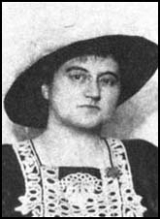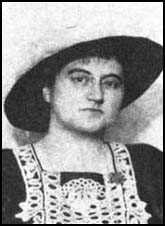
Women in Hungarian Politics
Encyclopedia
The roles of women in Hungary have changed significantly over the past 200 years. In the Kingdom of Hungary
, discourses on women’s roles, rights, and political access, along with feminist movements, have developed within the context of extremely traditional gender roles, and more recently, Communist doctrine on women’s place in society. The post-communist era
in Hungary has produced a number of organizations to address the needs of the nation’s women and mobilize female voters, and several universities now have gender studies programs.
In 1790 a man named Péter Bárány petitioned the National Gathering of Hungarian Noblemen to grant female nobles the right to observe parliamentary proceedings. He argued that these women would be better prepared to raise politically active, patriotic sons, but the assembly did not accept his petition.1 The first women’s organization to form in Hungary was the Pester Women's Charitable Society, founded in 1817; by the end of the nineteenth century there were several hundred similar organizations throughout the kingdom, although, for the most part, they had little involvement in politics.2 When women gained access to secondary education in the mid-nineteenth century, the large presence of active women’s groups helped win the students a more academic curriculum, rather than one that focused on being a wife and mother. In 1895 women were first allowed to study philosophy, medicine, and pharmacy at the university level.3
In addition to the advocacy of women’s groups, these advances were due, in part, to the Hungarian push to elevate its status as a power in the Austrian-Hungarian Empire, and present itself as an increasingly modernized region.
 In 1904, Rózsika Bédy-Schwimmer (Rosika Schwimmer
In 1904, Rózsika Bédy-Schwimmer (Rosika Schwimmer
), a pacifist and women’s rights advocate, founded the Association of Feminists.4 The group pushed for women's suffrage
and helped bring the issue to a parliamentary vote on three separate occasions, although each attempt was unsuccessful. The Men's League for Women's Suffrage
was founded in 1910, and in 1913 the 7th Congress of the International Women's Suffrage Alliance met in Budapest
.5 The Association of Feminists worked closely with the city council of Budapest to establish a women's aid office and day care centers; they also published a journal on women's issues that helped to raise public awareness of women's concerns.6 Other groups active in the early twentieth century included female members of the Social Democrats, and the National Federation of Women Clerical Workers, which sought improvements in the rights of female professionals.7
Following World War I, an independent Hungary began to define itself in a “national framework,” and the women’s movement shifted to fit into this new framework effectively.8
Following the brief Communist seizure of power by Béla Kun
in 1919, feminist groups, and other organizations considered revolutionary, became smaller, covert, and less influential; finding themselves in similar circumstances, some feminists, Communists, and other radicals formed working relationships. Hungarian women won partial suffrage and the right to serve in parliament, while the emergence of a party system of government gave women a new, socially accepted avenue for recognition and involvement. Women were particularly active in the National Unity Party
and the Christian Women’s Camp.9 As their political opportunities expanded, Hungarian women were simultaneously gaining attention and support in a very traditional role: as mothers and caretakers of the nation’s children.10 Beginning in 1941, women’s groups began to diverge further, due mainly to political events leading up to World War II.11
, sexuality, and family life.12 Women did see some gains under Communism, despite remaining subordinate to men; they received greater access to secondary and university education, especially in technical fields.13
Kingdom of Hungary
The Kingdom of Hungary comprised present-day Hungary, Slovakia and Croatia , Transylvania , Carpatho Ruthenia , Vojvodina , Burgenland , and other smaller territories surrounding present-day Hungary's borders...
, discourses on women’s roles, rights, and political access, along with feminist movements, have developed within the context of extremely traditional gender roles, and more recently, Communist doctrine on women’s place in society. The post-communist era
Post-Communism
Post-communism is a name sometimes given to the period of political and economic transformation or "transition" in former Communist states located in parts of Europe and Asia, in which new governments aimed to create free market-oriented capitalist economies with some form of parliamentary...
in Hungary has produced a number of organizations to address the needs of the nation’s women and mobilize female voters, and several universities now have gender studies programs.
Pre-WWI
In 1790 a man named Péter Bárány petitioned the National Gathering of Hungarian Noblemen to grant female nobles the right to observe parliamentary proceedings. He argued that these women would be better prepared to raise politically active, patriotic sons, but the assembly did not accept his petition.1 The first women’s organization to form in Hungary was the Pester Women's Charitable Society, founded in 1817; by the end of the nineteenth century there were several hundred similar organizations throughout the kingdom, although, for the most part, they had little involvement in politics.2 When women gained access to secondary education in the mid-nineteenth century, the large presence of active women’s groups helped win the students a more academic curriculum, rather than one that focused on being a wife and mother. In 1895 women were first allowed to study philosophy, medicine, and pharmacy at the university level.3
In addition to the advocacy of women’s groups, these advances were due, in part, to the Hungarian push to elevate its status as a power in the Austrian-Hungarian Empire, and present itself as an increasingly modernized region.

Rosika Schwimmer
Rosika Schwimmer or Bédy-Schwimmer "Rózsa" Rózsika was a Hungarian-born pacifist, feminist and female suffragist.Rosika Schwimmer was born on September 11, 1877 to a Jewish family in Budapest in Austria-Hungary...
), a pacifist and women’s rights advocate, founded the Association of Feminists.4 The group pushed for women's suffrage
Women's suffrage
Women's suffrage or woman suffrage is the right of women to vote and to run for office. The expression is also used for the economic and political reform movement aimed at extending these rights to women and without any restrictions or qualifications such as property ownership, payment of tax, or...
and helped bring the issue to a parliamentary vote on three separate occasions, although each attempt was unsuccessful. The Men's League for Women's Suffrage
Men's League for Women's Suffrage
The Men's League for Women's Suffrage was a society formed in 1907 by the left-wing writers Henry Brailsford, Max Eastman, Laurence Housman, Henry Nevinson and others to pursue women's suffrage.-External links:*...
was founded in 1910, and in 1913 the 7th Congress of the International Women's Suffrage Alliance met in Budapest
Budapest
Budapest is the capital of Hungary. As the largest city of Hungary, it is the country's principal political, cultural, commercial, industrial, and transportation centre. In 2011, Budapest had 1,733,685 inhabitants, down from its 1989 peak of 2,113,645 due to suburbanization. The Budapest Commuter...
.5 The Association of Feminists worked closely with the city council of Budapest to establish a women's aid office and day care centers; they also published a journal on women's issues that helped to raise public awareness of women's concerns.6 Other groups active in the early twentieth century included female members of the Social Democrats, and the National Federation of Women Clerical Workers, which sought improvements in the rights of female professionals.7
Between the Wars
Following World War I, an independent Hungary began to define itself in a “national framework,” and the women’s movement shifted to fit into this new framework effectively.8
Following the brief Communist seizure of power by Béla Kun
Béla Kun
Béla Kun , born Béla Kohn, was a Hungarian Communist politician and a Bolshevik Revolutionary who led the Hungarian Soviet Republic in 1919.- Early life :...
in 1919, feminist groups, and other organizations considered revolutionary, became smaller, covert, and less influential; finding themselves in similar circumstances, some feminists, Communists, and other radicals formed working relationships. Hungarian women won partial suffrage and the right to serve in parliament, while the emergence of a party system of government gave women a new, socially accepted avenue for recognition and involvement. Women were particularly active in the National Unity Party
National Unity Party
The National Unity Party or National United Party may refer to:* National Unity Party * National Unity Party of Canada* National Unity Party * National Unity Party...
and the Christian Women’s Camp.9 As their political opportunities expanded, Hungarian women were simultaneously gaining attention and support in a very traditional role: as mothers and caretakers of the nation’s children.10 Beginning in 1941, women’s groups began to diverge further, due mainly to political events leading up to World War II.11
Communist Era
Women were seen as a vital part of the productivity of the state, both as mothers and wives of male workers, and as workers themselves. Although women were included in the blue-collar workforce in a more equal way under Communist rule, they generally were placed under greater male control, especially concerning reproductive rightsReproductive rights
Reproductive rights are legal rights and freedoms relating to reproduction and reproductive health. The World Health Organization defines reproductive rights as follows:...
, sexuality, and family life.12 Women did see some gains under Communism, despite remaining subordinate to men; they received greater access to secondary and university education, especially in technical fields.13

